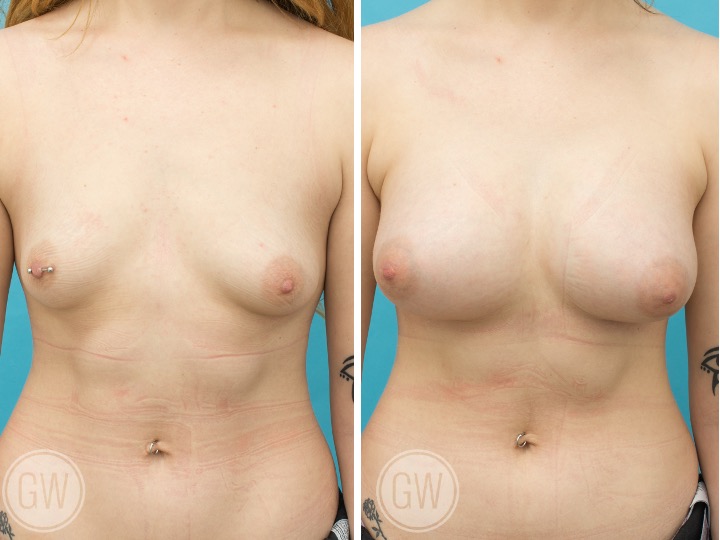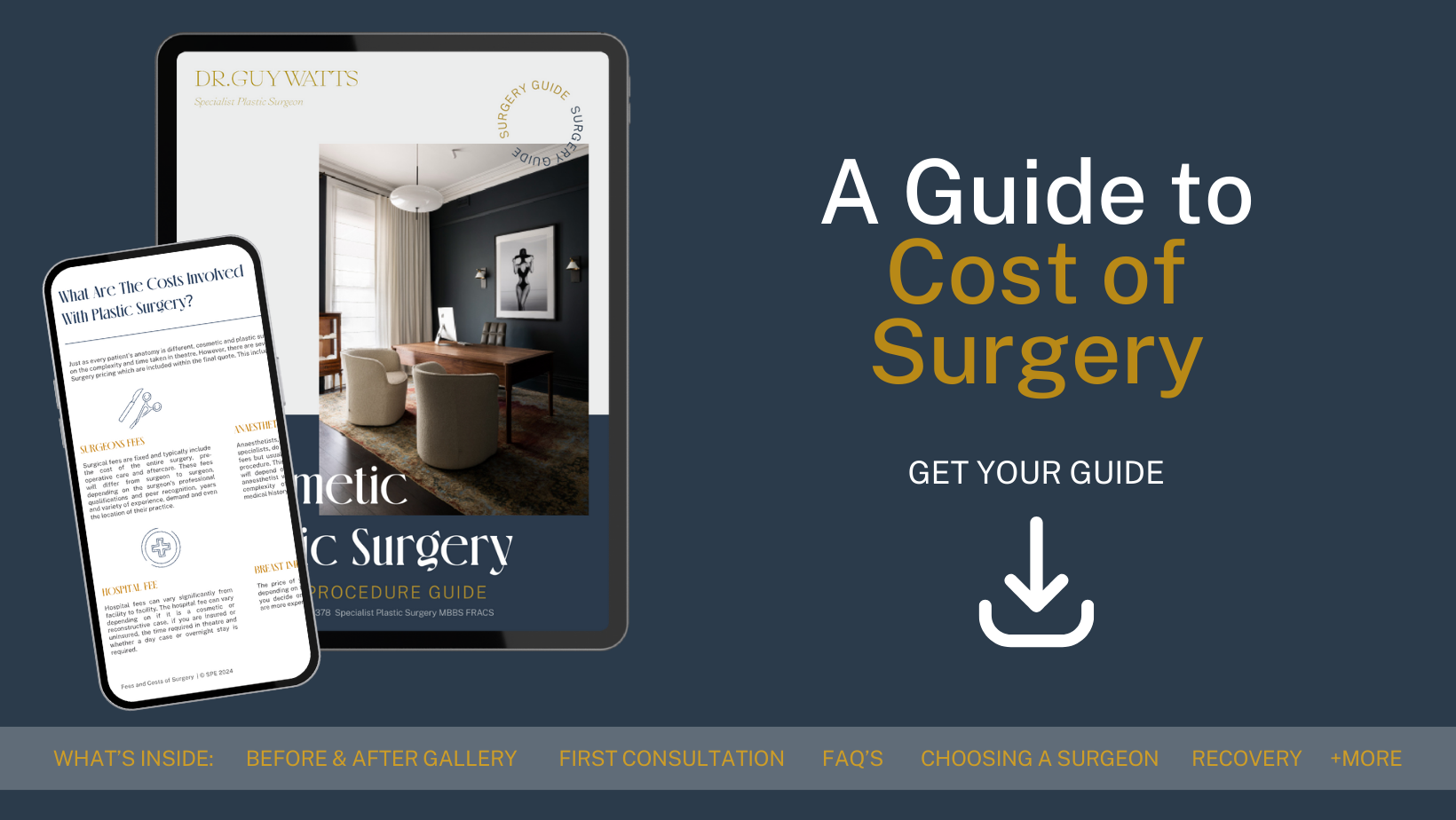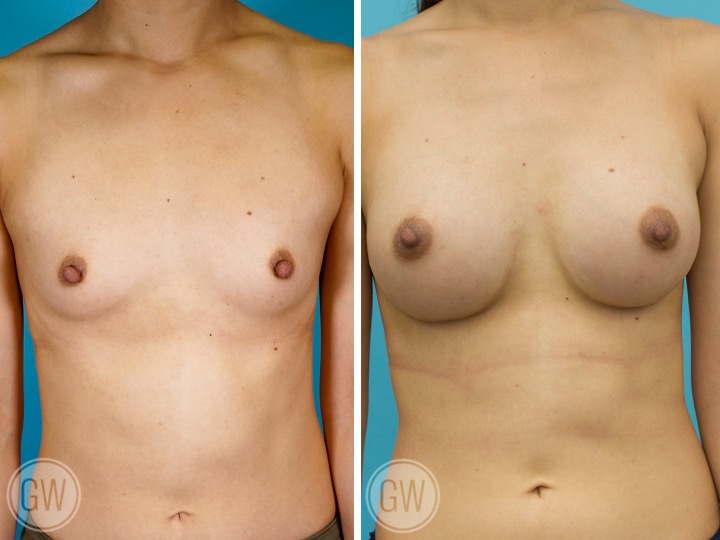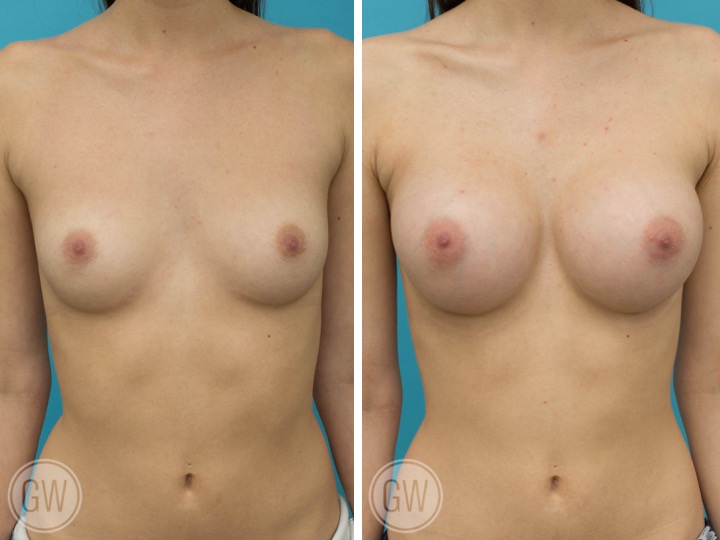
27 Aug Exercising After Breast Implant Surgery – Timeline and Tips
After breast implant surgery, many individuals are eager to return to their usual physical routines. Whether it’s light walking, gym training, or team sports, exercise plays a critical role in long-term health and mental wellbeing. However, immediate post-operative movement must be approached with care to support proper healing, reduce complication risks, and preserve implant positioning.
Dr Guy Watts, Specialist Plastic & Reconstructive Surgeon in Perth, Western Australia, provides personalised guidance to help his patients safely reintroduce physical activity. His recovery protocols prioritise stability, comfort, and gradual progression tailored to each patient’s unique goals and physiology.
Take our quiz, and find out if you are ready for surgery
Why Post-Surgical Exercise Should Be Approached Cautiously
Engaging in movement after surgery has many benefits. It supports blood circulation, reduces the risk of blood clots, and promotes psychological wellbeing by improving mood and reducing anxiety. It can also support digestion, help manage swelling, and improve sleep quality.
However, the breast implant procedure involves surgical manipulation of soft tissues, which need time to settle. The initial healing phase is critical for maintaining implant position and supporting tissue recovery without disruption. Exercise that is too vigorous or introduced too early can lead to:
- Implant displacement or rotation, which may require revision surgery if left uncorrected.
- Wound complications, such as delayed healing or dehiscence (wound reopening).
- Seroma formation, where fluid accumulates around the implant or surgical site, leading to discomfort and potential infection risk.
- Capsular contracture, a condition where scar tissue around the implant tightens, causing firmness or distortion of the breast.
Dr Watts’ approach is built around prevention. His clinical reviews, conducted in his Perth-based clinic, allow him to monitor healing closely and adjust movement guidelines accordingly.
Breast Implant Recovery Timeline for Exercise: What to Expect
This timeline reflects a gradual return to activity. Each stage aligns with the typical phases of soft tissue healing. However, recovery can vary based on implant type, placement, and the patient’s general health, making regular follow-up essential.
Week 1-2: Rest and Gentle Walking
During the first two weeks, the body prioritises wound healing and early tissue repair. At this stage, the focus is on minimal movement.
- Goals: Allow internal sutures and tissues to stabilise without disruption. Movement should be minimal and gentle, with the goal of maintaining circulation to prevent blood clots (deep vein thrombosis).
- Activities Allowed:
- Short, slow walks indoors every few hours are encouraged. These can be 10-15 minutes in duration and should be done without raising the arms or brisk pacing.
- Basic movements like walking to the bathroom, standing briefly at a kitchen bench, or sitting outside are safe.
- What to Avoid:
- Lifting any object over 2-3 kilograms, including children or heavy handbags.
- Reaching for items on high shelves or stretching arms above shoulder height.
- Any abdominal, chest or upper back activation, including getting out of bed using the arms.
- Supportive Care:
- Patients should wear a post-operative surgical bra continuously, including during sleep. These bras are designed to reduce implant movement and support wound healing.
- It is also recommended to sleep on your back with the upper body slightly elevated using pillows or a wedge, to reduce swelling and tension at the surgical site.
Week 3-4: Light Daily Activities
As tissues begin to mature, light physical activity becomes safer. This stage requires careful balance – not too much, not too little.
- Goals: Reintroduce basic daily activities without engaging the chest or upper limbs in any strenuous way. Focus on gentle mobility and gradual energy restoration.
- Activities Allowed:
- Walking outdoors on flat ground at a relaxed pace for 15-30 minutes.
- Light household tasks like preparing meals, washing dishes, or folding clothes.
- Dressing and grooming without overhead arm use (e.g., button-up clothing rather than pullovers).
- Avoid:
- Any lifting, pushing or pulling, including doors that require force.
- Resuming work that requires physical effort, such as cleaning, gardening, or caring for small children.
- Driving is typically discouraged unless the patient has ceased pain medication and can perform necessary safety maneuvers without discomfort.
Although patients may feel more confident and comfortable, it is important to stay within the limits advised by Dr Watts and attend your scheduled post-operative check at his Perth clinic for clearance before progressing further.
Week 5-6: Lower Body Movement and Mild Cardio
This phase marks the beginning of more structured movement, especially for those eager to maintain cardiovascular health and leg strength.
- Goals: Reintroduce light cardiovascular activity while continuing to protect upper body and implant positioning.
- Activities Allowed:
- Stationary cycling with low resistance settings is generally acceptable. Set the handlebars to a height that allows an upright posture without forward lean..
- Bodyweight lower-body exercises such as heel raises, step-ups, or short wall-sits may be introduced with caution.
- Brisk walking outdoors or on a treadmill can be performed for longer periods (up to 45 minutes) if no discomfort is felt.
- Considerations:
- Movements should avoid jolting or bouncing of the upper body. If any tightness, pulling, or discomfort is noted in the chest, the activity should be paused.
- Wear a high-support sports bra even during low-impact activity to prevent breast movement.
At this point, patients in Perth are typically reviewed again by Dr Watts to assess wound healing, implant position, and readiness for gradual activity escalation.
Week 7-12: Gradual Reintroduction of Full-Body Workouts
As tissue strength and implant stabilisation improve, more types of movement can be reintroduced under medical supervision.
- Goals: Improve cardiovascular endurance and muscular strength while protecting long-term surgical outcomes.
- Activities Allowed:
- Light dumbbell training for the lower body, such as lunges or resistance band work.
- Modified yoga or Pilates that avoids prone positions or chest compression. Focus on breathing, posture, and core stability.
- Elliptical trainers and gentle treadmill jogging can be considered at the 10-12 week mark, if cleared by the surgeon.
- Upper Body:
- Small, controlled upper body movements with light weights (1-2kg max) may be introduced only if tissue healing is confirmed.
- Arm circles, light bicep curls, and shoulder rolls can help restore mobility without strain.
Progress should always be tracked. Dr Watts may request patients return for physical reviews and photos to compare implant positioning and symmetry during this phase.
Beyond 12 Weeks: Structured Exercise with Clinical Oversight
Once the 12-week milestone is reached, most patients are ready to resume broader forms of exercise with confidence.
- Goals: Re-establish previous routines, reintroduce upper body strength work, and engage in sport or high-impact training if desired.
- Activities Allowed:
- Full-body weight training programs, starting with moderate resistance and progressing slowly.
- Swimming, high-impact cardio (e.g., HIIT or running), and contact sports with caution.
- Group fitness classes, reformer Pilates, and CrossFit may be resumed after individual assessment.
It remains important to continue wearing supportive sports bras, particularly during activities involving running, jumping, or directional changes. Dr Watts continues to offer long-term follow-up for patients at his Perth clinic to support the maintenance of breast implant results.
DOWNLOAD DR WATTS’ COST OF SURGERY ULTIMATE GUIDE

Exercises to Avoid in the Early Stages
The following exercises place undue stress on healing tissues or the implant pocket and should be strictly avoided in the first 6-12 weeks:
- Upper body resistance training such as chest presses, lat pulldowns, shoulder presses, and triceps dips, which can stretch or displace implants.
- High-impact movements, including jogging, burpees, jumping jacks, or trampoline exercises that may cause vertical displacement or strain.
- Overhead lifting, even when lightweight, can pull on sutures and increase the risk of swelling or delayed healing.
- Swimming or aquatic exercise should also be avoided until the surgical wounds are fully closed and cleared by your surgeon to prevent infection or implant exposure to bacteria.
Tailored Recovery for Different Activity Levels
For Active Individuals:
Patients who were regularly exercising before surgery often find reduced mobility frustrating. Dr Watts tailors plans to include safe alternatives, such as using resistance bands for seated leg work, recumbent bikes, or breath-based core stability.
For Those New to Exercise:
Breast implant recovery can be an opportunity to build healthy habits. Starting with guided walking plans and gentle strength work supports both recovery and long-term health. Dr Watts and his team offer supportive recommendations that help these patients feel empowered.
For Sports or High-Performance Patients:
Returning to professional sport or athletic training demands detailed rehabilitation schedules. Whether it’s a swimmer, netballer, or bodybuilder, Dr Watts provides clear, progressive timelines aligned with performance goals while minimising surgical risk.
When to Pause or Seek Reassessment
Certain signs may suggest that physical activity is too aggressive or inappropriate at a given stage:
- Sharp or pulling pain in the breast or chest area that increases with movement may indicate tissue irritation or strain.
- Swelling that increases after activity, rather than reducing with rest, should be reported.
- Visible shifting or asymmetry in the breasts following physical effort can be a sign of implant movement.
- Sensation of tightness or pressure, especially on one side, may suggest seroma, fluid build-up, or early capsular contracture.
Patients should not wait until routine follow-ups if concerned. Dr Watts’ Perth clinic offers timely post-operative reviews and provides guidance on adjusting activity levels to help prevent issues from developing.
Practical Tips for Safe Exercise After Surgery
- Wear the right support garments. A high-quality, post-surgical or supportive sports bra reduces breast movement and provides gentle compression. Avoid underwire bras during healing.
- Hydrate consistently. Adequate fluid intake supports cellular repair, joint function, and energy regulation – especially important in Perth’s warmer climate.
- Eat balanced meals. Protein-rich, anti-inflammatory foods support tissue recovery and immune health.
- Avoid saunas and hot yoga. Excessive heat may contribute to inflammation, interfere with wound healing, or increase infection risk.
- Progress gradually. Begin with low resistance and short sessions. If tolerated well, increase duration or intensity slightly each week.
- Use mirrors or video. Visual feedback can help monitor body symmetry and support the development of correct movement patterns.
Dr Guy Watts’ Role in Post-Surgical Exercise Planning
Dr Guy Watts provides comprehensive recovery support as part of his surgical care in Perth. His involvement includes:
- Initial planning and education, offering written and verbal guidance before surgery.
- Staged return-to-movement advice, based on operative findings and implant placement.
- Ongoing post-operative assessments, often at 1, 2, 6, and 12 weeks, help guide exercise so it remains appropriate for the stage of tissue healing.
- Access to allied health referrals, including physiotherapy or rehabilitation for complex cases.
Each patient receives individualised care aimed at maintaining their surgical outcome, lifestyle, and long-term health.
FAQs About Exercising After Breast Implant Surgery
Next Steps: Prioritising a Safe and Supported Recovery
Returning to physical activity after breast implant surgery is a process that requires patience, planning, and guidance. While staying active is important for overall health, ensuring the body has adequate time to heal is critical to protect the integrity of the surgical outcome.
Each individual’s recovery journey is different. Factors such as implant type, placement, personal fitness level, and lifestyle all influence how and when exercise can be safely resumed. A one-size-fits-all approach does not apply – clinical input is essential.
Dr Guy Watts, Specialist Plastic & Reconstructive Surgeon in Perth, supports patients through every stage of recovery with detailed reviews and tailored advice. By attending scheduled follow-ups and asking questions about return-to-activity planning, patients can feel more confident in their progress and their care.
If you’re considering breast implant surgery or would like guidance on post-operative recovery, you are welcome to contact Dr Watts’ Perth clinic to arrange a consultation. His approach is focused on patient education, surgical precision, and ongoing support throughout your care journey.
Further Reading
-
- Read more on Dr Watts’ blog about Returning To Exercise After Breast Augmentation Surgery
- Read more on Dr Watts’ blog about Recovery after Breast Lift
About Dr. Guy Watts – MED0001539378
FRACS (Plas) – Specialist Plastic Surgeon In Perth WA
Dr. Guy Watts is a Specialist Plastic Surgeon (AHPRA MED0001539378) with an extensive career that spans across renowned plastic surgery clinics worldwide. His experience has been honed through invaluable experiences at esteemed establishments such as the New York Eye and Ear Infirmary and the renowned Pitanguy Clinic in Brazil.
Having collaborated with the foremost cosmetic plastic surgeons on a global scale, Dr. Watts has chosen to return to Perth after a 17-year journey of intensive training and invaluable professional experience to bring the latest practices and technology in cosmetic plastic surgery to his patients.
Dr. Watts is a Fellow of the Royal Australasian College of Surgeons (FRACS) and a Member of the Australian Society of Plastic Surgeons (ASPS), Australasian Society of Aesthetic Plastic Surgeons (ASAPS) and the International Society of Aesthetic Plastic Surgeons (ISAPS).
Read about the potential Risks and Complications of Surgery
Read the Patient Information and Resources
About CLINISPA
Clinispa is Dr Watts’ bespoke medical clinic performing Cosmetic Aesthetic treatments. At Clinispa, we offer advanced clinical treatments in a luxurious and calming environment, tailored to support your skin’s health and appearance.
Clinispa aesthetic services are performed by Dr Guy Watts’ nursing professionals, who have a passion for and solid understanding of facial aesthetics.
All Clinispa clients are considered individually, with a personalised treatment plan consisting of advanced scientific approaches to cosmetic aesthetics. We incorporate innovative technologies in conjunction with superiorly formulated skin care.
For more information about the full range of Clinispa Aesthetic of Cosmetic Treatments visit the Clinispa website










Sorry, the comment form is closed at this time.